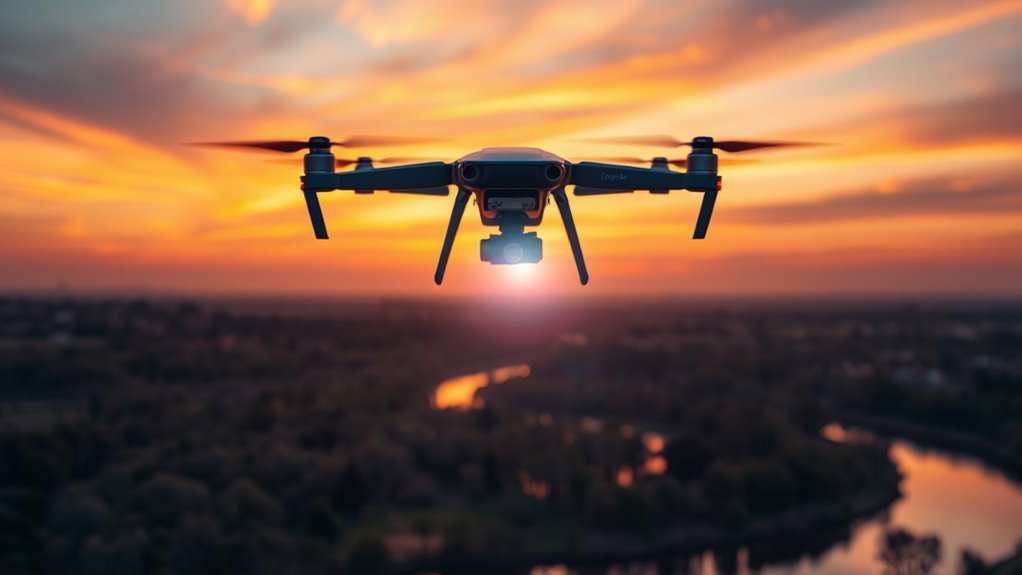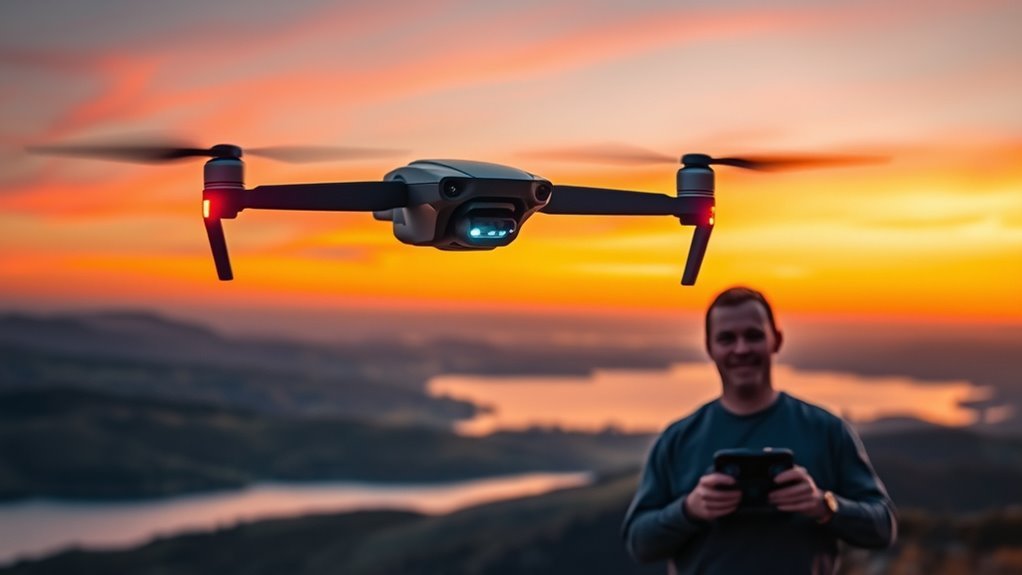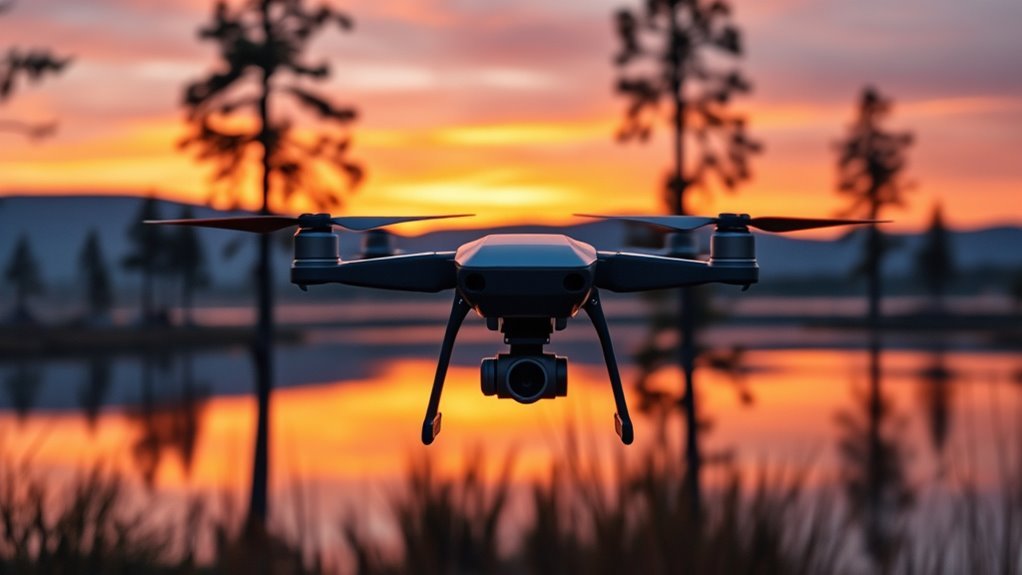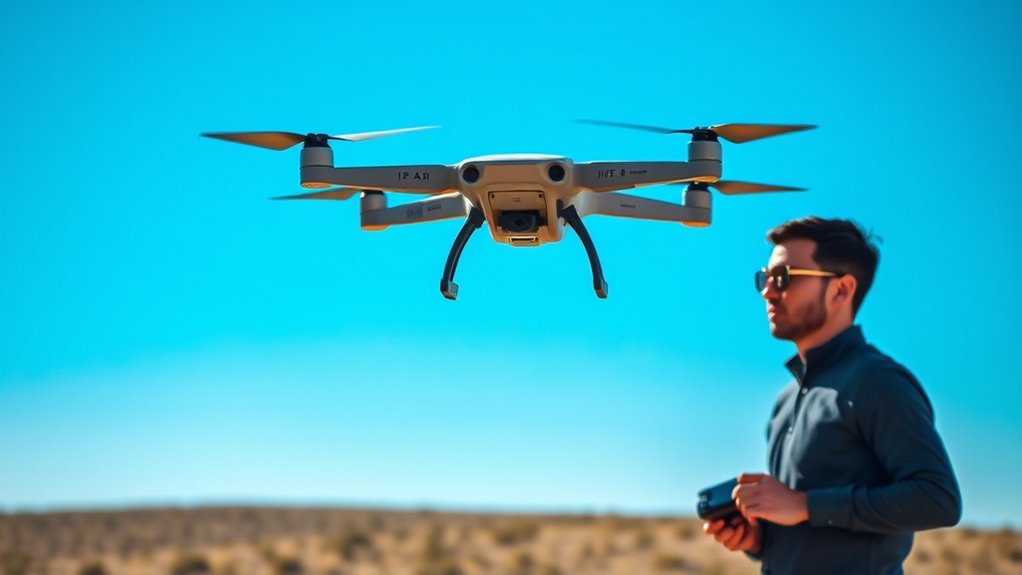Drone headless mode simplifies navigation by allowing you to control the drone’s movements based solely on your perspective, disregarding its orientation. When activated, forward commands always lead the drone in the same direction relative to you, enhancing control and reducing confusion. This feature is especially beneficial for beginners, making it easier to maneuver without worrying about the drone’s facing direction. Learn more about its benefits, limitations, and effective flying tips.
Understanding Headless Mode

Understanding Headless Mode is vital for maximizing your drone’s usability, especially when you’re maneuvering in complex environments. In this mode, the drone’s orientation becomes irrelevant to its navigation, simplifying control. Instead of relying on its forward-facing direction, you can direct the drone based on your perspective, making it easier to execute precise maneuvers. This is particularly beneficial in challenging flight mechanics, where orientation can become disorienting. By mastering Headless Mode, you enhance your drone navigation capabilities, allowing for more freedom in operation. You’ll find it especially useful in tight spaces or during aerial photography, where quick, responsive adjustments are essential. Embracing this mode can greatly elevate your flying experience and expand your creative possibilities.
How Headless Mode Works

When you activate Headless Mode, the drone’s onboard software recalibrates its navigation system to align with your controller’s orientation rather than its own. This transformation simplifies control, allowing you to maneuver freely without worrying about the drone’s facing direction. The headless mode mechanics utilize sensors to track your inputs, ensuring that forward translates to forward, no matter the drone’s position.
| Controller Direction | Drone Response | User Experience |
|---|---|---|
| Forward | Moves forward | Empowered |
| Backward | Moves backward | In control |
| Left | Moves left | Liberated |
| Right | Moves right | Confident |
| Hover | Stays in place | Grounded |
Employing these drone navigation techniques, you gain an enhanced sense of freedom during flight.
Benefits of Using Headless Mode

Using headless mode greatly simplifies control mechanics, allowing you to focus on maneuvering without worrying about the drone’s orientation. This mode enhances your awareness, making it easier to maintain a consistent flight path regardless of the drone’s position. As a result, it can improve your overall flying experience, especially for beginners.
Simplified Control Mechanics
Headless mode greatly simplifies drone control mechanics, allowing pilots to focus on navigation without worrying about the orientation of the aircraft. With user-friendly controls, you can maneuver your drone effortlessly, as forward and backward commands correspond to your perspective rather than the drone’s front. This feature enhances simplified navigation, particularly for novice operators who might struggle with traditional control schemes. By eliminating the need for constant adjustments based on the drone’s position, you can concentrate on your flight goals, maximizing your aerial freedom. The intuitive interface lets you explore complex environments with confidence, giving you the ability to enjoy piloting without the stress of maintaining directional awareness. Overall, headless mode turns flying into a more accessible and enjoyable experience.
Enhanced Orientation Awareness
Although many pilots find traditional drone controls challenging, headless mode greatly enhances orientation awareness by aligning the drone’s movements with the operator’s perspective. This feature eliminates the confusion often associated with orientation techniques, allowing you to focus on your flight without worrying about which direction the drone is facing. By utilizing navigation aids, headless mode facilitates smoother maneuvering, especially in complex environments. You’ll experience increased confidence as you navigate, knowing that the drone responds consistently to your commands regardless of its orientation. This capability not only simplifies flight but also liberates your creativity, enabling you to explore and capture stunning aerial footage with ease. Embracing headless mode can markedly improve your overall piloting experience.
When to Use Headless Mode
You should consider using headless mode when guiding your drone as a beginner, as it simplifies control by aligning the drone’s movements with your perspective. This mode is also advantageous in windy conditions, providing stability and ensuring consistent flight paths. Additionally, it aids in avoiding obstacles, enhancing your ability to maneuver in complex environments.
Beginner Friendly Navigation
When maneuvering a drone for the first time, understanding its orientation can be challenging, especially when you’re trying to maintain control in various flying conditions. This is where headless mode can be invaluable for beginner drone navigation. It simplifies control, allowing you to focus on flying rather than the drone’s orientation.
- It eliminates confusion about forward and backward.
- You can easily execute maneuvers without worrying about the drone’s nose direction.
- It enhances your confidence as you learn the basics of drone operation.
Using headless mode is a great beginner tip, providing a smoother entry into the world of drone flying. It empowers you to explore your flying potential without the intimidation of complex controls.
Stability in Windy Conditions
Flying a drone in windy conditions can pose significant challenges, especially for beginners. When you’re battling wind resistance, headless mode can enhance flight stability by simplifying control. In this mode, the drone’s orientation becomes irrelevant; forward movement always corresponds to the front of the drone from your perspective. This feature allows you to focus on maintaining altitude and steering without worrying about the drone’s actual direction. If you find yourself in strong winds, activating headless mode can minimize disorientation and help you maintain control. It’s particularly useful when you’re attempting to reposition or land, as it aids in countering the effects of wind, ultimately allowing you to operate your drone with greater confidence and accuracy.
Avoiding Obstacles Easily
While managing wind resistance is important, maneuvering obstacles presents its own set of challenges. When using headless mode, you can enhance your drone navigation, allowing for easier obstacle avoidance. This mode simplifies directional inputs, making it ideal for complex environments.
- You’ll maintain control, even when your drone’s orientation is unclear.
- It helps prevent crashes by allowing you to focus on navigation rather than direction.
- Headless mode is especially useful in tight spaces or when flying close to objects.
In these situations, the typical directional commands may become counterintuitive. Activating headless mode lets you pilot your drone with confidence, ensuring that you can navigate around obstacles seamlessly while enjoying the freedom that drone flying offers.
Limitations of Headless Mode
Although headless mode simplifies control for novice pilots, it comes with several limitations that can hinder flight performance. One major limitation is the potential for disorientation; since the drone’s orientation is based on the pilot’s position, losing sight of the drone can lead to confusion. Additionally, headless mode can reduce a user’s overall understanding of flight mechanics, limiting their ability to maneuver effectively in standard mode later. The lack of precise directional feedback can also result in jerky movements, negatively impacting the user experience. Finally, reliance on headless mode might prevent pilots from developing essential skills, which can restrict their freedom to explore more complex flying techniques. Understanding these headless mode limitations is vital for aspiring drone pilots.
Comparing Headless Mode to Standard Flight Mode
Headless mode offers a simplified flying experience, but it operates quite differently from standard flight mode, which relies on a drone’s orientation. In headless mode, the drone responds based on your perspective, removing the need to constantly adjust for its direction. This can greatly enhance user experience differences, particularly for beginners.
- Intuitive control: You’ll find it easier to maneuver without worrying about the drone’s front.
- Learning curve: Headless mode can reduce the time needed to master basic flying skills.
- Limitations on precision: Standard flight mode offers more control for advanced maneuvers.
Additionally, many entry-level drones, such as the Holy Stone HS710, feature headless mode, making them more accessible for new pilots. In headless mode vs. standard flight, the choice depends on your comfort level and flying goals, balancing freedom with control.
Tips for Flying in Headless Mode
How can you maximize your flying experience in headless mode? First, familiarize yourself with the drone’s orientation before taking off. This’ll help you understand how it responds to your commands. Use smooth movements when controlling the drone to maintain stability; sudden jerks can lead to disorientation. Implement flying techniques like practicing figure-eights and circles to gain confidence in your control. Always keep the drone within your line of sight to avoid losing track of its orientation. Pay attention to battery levels, as low power can affect responsiveness. Finally, take advantage of control tips such as adjusting the sensitivity settings if available—this can enhance your flying precision. Embrace the freedom that headless mode offers, but remain mindful of your surroundings.
Popular Drones With Headless Mode Feature
When you’re looking for drones that feature headless mode, several popular models stand out for their user-friendly design and reliable performance. These drones simplify navigation, making them ideal for both beginners and experienced pilots. Here are a few remarkable options:
Drones with headless mode offer easy navigation, perfect for both novice and seasoned pilots alike.
- DJI Mini SE: Known for its compact size and excellent camera quality, it integrates headless mode for easy control.
- Holy Stone HS720: This model combines advanced features with headless mode, making it a favorite among drone enthusiasts. Additionally, its collision avoidance system enhances safety during flight, providing peace of mind for users.
- Snaptain SP350: With its intuitive controls and budget-friendly price, it offers an accessible entry point for newcomers.
Additionally, many of these drones, such as the Holy Stone HS720, are praised for their flight performance and obstacle avoidance features, enhancing the overall flying experience. Each of these popular drone brands has received positive headless mode reviews, ensuring you can fly confidently and freely.
Safety Considerations While Using Headless Mode
While flying a drone in headless mode can simplify navigation, it’s vital to remain vigilant about safety considerations. Prioritizing accident prevention and enhancing pilot awareness is fundamental. Here’s a quick reference table to help you stay focused:
| Safety Aspect | Importance | Action Required |
|---|---|---|
| Environment Assessment | Reduce collision risks | Survey surroundings |
| Battery Monitoring | Prevent crashes due to power loss | Check battery levels |
| Control Responsiveness | Maintain flight stability | Verify controls are responsive |
| Emergency Protocols | Quick recovery from issues | Familiarize with emergency procedures |
| Flight Limits | Avoid legal trouble | Know local regulations |
Frequently Asked Questions
Can Headless Mode Be Used in All Weather Conditions?
Headless mode can be used in various weather conditions, but you should consider drone stability. Wind and rain can affect performance, so assess weather considerations carefully to guarantee peak control and safety during your flights.
Does Headless Mode Affect Battery Life?
When you engage headless mode, it doesn’t considerably impact battery efficiency or flight duration. Instead, it enhances control, allowing you to explore freely without worrying about orientation, ultimately preserving your drone’s performance.
Is Headless Mode Suitable for Racing Drones?
Headless mode isn’t ideal for racing drones due to control limitations. While it offers simplicity, it compromises racing advantages like precision and responsiveness. For peak performance, stick to traditional controls to maximize your racing experience.
Can You Turn off Headless Mode During Flight?
Oh, the irony! You’d think during flight, you could just toggle headless mode off like a light switch. However, many drones restrict changing flight controls mid-air, keeping you tethered to the current orientation.
How Does Headless Mode Impact Drone Navigation Accuracy?
Headless mode simplifies navigation stability, enhancing your user experience by allowing drones to respond intuitively regardless of orientation. However, this can occasionally reduce navigation accuracy, as the drone may drift from intended paths under certain conditions.

